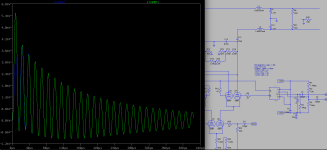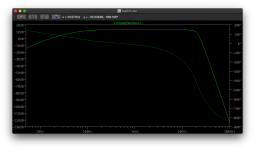You are using an out of date browser. It may not display this or other websites correctly.
You should upgrade or use an alternative browser.
You should upgrade or use an alternative browser.
Nick's little project
- Thread starter NickK
- Start date
More options
View all postsOk there were some serious issues with the LTSpice modelling of the 74HC chip (it's a digital chip that runs 0-5V but we're running at -137 (0V) to -132 (5V) relative. So after some (a lot) messing around...
Here is the ValveDAC output on start up
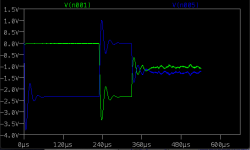
At 130uS the left chip voltages cause a first trip, then at 300uS the other chip finally gets down to -137 (this is due to the coupling capacitors). Then the system is just running 01010101010101... DSD 512 bitstream which gives a differential output (both present in the plot) that should = 0V when combined.
Not bad - 100+ year old tech running DSD512 DSD512 is 512 times the sample rate of a CD.
DSD512 is 512 times the sample rate of a CD.
Now to the fun bit - if I switch out the e88cc valves to 6SN7s and tweak then this can directly drive the 6as7 output tubes into my headphones (32ohm) or direct into high impedance headphones!
Here is the ValveDAC output on start up

At 130uS the left chip voltages cause a first trip, then at 300uS the other chip finally gets down to -137 (this is due to the coupling capacitors). Then the system is just running 01010101010101... DSD 512 bitstream which gives a differential output (both present in the plot) that should = 0V when combined.
Not bad - 100+ year old tech running DSD512
 DSD512 is 512 times the sample rate of a CD.
DSD512 is 512 times the sample rate of a CD.Now to the fun bit - if I switch out the e88cc valves to 6SN7s and tweak then this can directly drive the 6as7 output tubes into my headphones (32ohm) or direct into high impedance headphones!
Last edited:
So I will say nothing is 'new' and the designs and ideas are probably about there but I've been on a bit of a journey to understand the technology (tubes) understand the designs and the tools.
My guiding principles are:
* Low noise
* Tube stages - with a little help from solid state if needed.
* Headphones - capable of 32ohms
* Class A / AB1
* 6SN7 and 6AS7 based
Design topologies I've experiemented at in my earlier stages:
* SE 6SN7 -> 6AS7
* 6SN7 phase split using concertina -> 6AS7 PP
* 6SN7 input -> 6SN7 LTP -> 6AS7 PP
* 6SN7 other variants of 6SN7 drivers, differential amps, etc
* Negative feedback
* 6SL7 ..
* A 6SN7 version of Marcel's Valve DAC - including driving 6AS7 PP...
So from a LTSpice perspective I feed comfortable with the 6SN7 and 6AS7 and 'ideally' getting what I want...
So with the last piece it's got me thinking of the first stage - and how could I combine common components for the Valve DAC (requires six 6SN7 for both channels).
Then last night I thought - ignore everything you have done, focus on point 1 - noise. After reading around.. focusing on low noise designs for tube amps, removal of caps, reduction of resistors, paralleled tubes, differentials, and ensuring the majority of gain happens in one stage. Some of the ideas I was thinking about:
* Max 3 6SN7s - a total of 6 triodes available
* reduce resistors, capacitors in path
* Earliest gain possible
* Parallel - increase SNR
* Differential - reducing common noise
* Cascode - increasing gain without needing a coupling cap
I found a different back end stage - balanced but given the topology and the use of non-balanced headphones I would prefer PP with an output cap plus crowbar for safety.
So this morning I have decided on this topology:
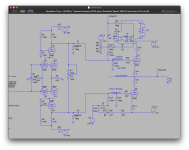
The volume control is phase based. As a differential amplifier amplifies the difference and rejects the common signals, by varying the scale of the difference, it's possible to (a) control the volume (b) present noise on both channels (which results in noise been cancelled in the output stage) and (c) sticking with best practice of not putting a variable resistor ahead of the input stage.
I've just done the first run with some guesstimate non calculated cap and resistor values - even the bias on the tubes is not correct at the moment. However it looks promising:
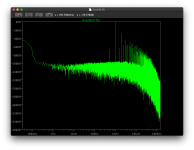
So I think I will continue down the path of this topology as it's looking promising without correct values or negative feedback.
Just trying a feedback version - it takes a good 30 seconds for the system to stabilise but a 5 minute run should give an idea of the frequency spectrum.
My guiding principles are:
* Low noise
* Tube stages - with a little help from solid state if needed.
* Headphones - capable of 32ohms
* Class A / AB1
* 6SN7 and 6AS7 based
Design topologies I've experiemented at in my earlier stages:
* SE 6SN7 -> 6AS7
* 6SN7 phase split using concertina -> 6AS7 PP
* 6SN7 input -> 6SN7 LTP -> 6AS7 PP
* 6SN7 other variants of 6SN7 drivers, differential amps, etc
* Negative feedback
* 6SL7 ..
* A 6SN7 version of Marcel's Valve DAC - including driving 6AS7 PP...
So from a LTSpice perspective I feed comfortable with the 6SN7 and 6AS7 and 'ideally' getting what I want...
So with the last piece it's got me thinking of the first stage - and how could I combine common components for the Valve DAC (requires six 6SN7 for both channels).
Then last night I thought - ignore everything you have done, focus on point 1 - noise. After reading around.. focusing on low noise designs for tube amps, removal of caps, reduction of resistors, paralleled tubes, differentials, and ensuring the majority of gain happens in one stage. Some of the ideas I was thinking about:
* Max 3 6SN7s - a total of 6 triodes available
* reduce resistors, capacitors in path
* Earliest gain possible
* Parallel - increase SNR
* Differential - reducing common noise
* Cascode - increasing gain without needing a coupling cap
I found a different back end stage - balanced but given the topology and the use of non-balanced headphones I would prefer PP with an output cap plus crowbar for safety.
So this morning I have decided on this topology:

The volume control is phase based. As a differential amplifier amplifies the difference and rejects the common signals, by varying the scale of the difference, it's possible to (a) control the volume (b) present noise on both channels (which results in noise been cancelled in the output stage) and (c) sticking with best practice of not putting a variable resistor ahead of the input stage.
I've just done the first run with some guesstimate non calculated cap and resistor values - even the bias on the tubes is not correct at the moment. However it looks promising:

So I think I will continue down the path of this topology as it's looking promising without correct values or negative feedback.
Just trying a feedback version - it takes a good 30 seconds for the system to stabilise but a 5 minute run should give an idea of the frequency spectrum.
For kicks just connected the feedback and ran it for a 5 min run (still not updated the values so this is like random values at the moment) - this is a slice after stabilisation with the negative feedback.. I thought - god that's awful! The I noted the scale on the side.. I'm starting to like this topology..
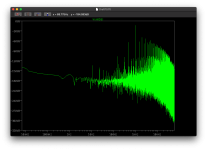

So I had a bit of brainwave last night at 4am.. so I had to get up and try it. Instead of using a bypass resistor to increase the current in the front stage, I've added another 6SN7 as a second cascode but this time providing output to the alternative phase. This means noise from one side is then present on both channels - which is what you want. The differential amp of the push pull then cancels out the noise and you get the difference between the two signals.. Also increased the B+ to 600V to give the cascode stacks more headroom and allow a higher value Ra to increase the peak-to-peak output.
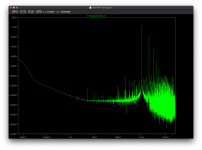
This is without negative feedback and class A.
I made a change after starting the simulation (set to maximum accuracy at the expense of speed) so the cascode grids are tied in the simulation but not in the diagram.
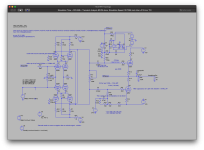
U4 (signal) & U1 are a differential pair in a parallel formation with U5 & U2.
* Parallelled increases the signal to noise ratio, so less noise.
* this is a differential input stage and can be switched to take a balanced input from source, or, a single ended input as defined here. It outputs a differential - so it's the difference between the two outputs that is amplified, common signals such as the same noise are then cancelled out.
U6 is a cascode for U4 & U5, it increases the bandwidth but reduces the gain and peak to peak output, U10 is the 'anti'-cascode for U4 & U5 it's role is to pull current but instead of add signal, it's to provide the anti-phase signal and the noise from U4 & U5 etc to the anti-phase channel (U1... U7).
The front end is mirrored U1,U2,U3,U9, doing the same - except it's noise is copied across to the in-phase channel.
U7 and U8 are the output stage - as a push pull they will cancel out any common signals such as the same noise, and amplify the difference between the two phase channels as the output.
Volume control (R11, R12) works by allowing the phases to cancel each other out reduce the amplitude. It's current set to max volume.

This is without negative feedback and class A.
I made a change after starting the simulation (set to maximum accuracy at the expense of speed) so the cascode grids are tied in the simulation but not in the diagram.

U4 (signal) & U1 are a differential pair in a parallel formation with U5 & U2.
* Parallelled increases the signal to noise ratio, so less noise.
* this is a differential input stage and can be switched to take a balanced input from source, or, a single ended input as defined here. It outputs a differential - so it's the difference between the two outputs that is amplified, common signals such as the same noise are then cancelled out.
U6 is a cascode for U4 & U5, it increases the bandwidth but reduces the gain and peak to peak output, U10 is the 'anti'-cascode for U4 & U5 it's role is to pull current but instead of add signal, it's to provide the anti-phase signal and the noise from U4 & U5 etc to the anti-phase channel (U1... U7).
The front end is mirrored U1,U2,U3,U9, doing the same - except it's noise is copied across to the in-phase channel.
U7 and U8 are the output stage - as a push pull they will cancel out any common signals such as the same noise, and amplify the difference between the two phase channels as the output.
Volume control (R11, R12) works by allowing the phases to cancel each other out reduce the amplitude. It's current set to max volume.
I've been tuning quite a bit:
* Stacks are running +300 to -300 rather than 0-600V. There's an option to here to 'fold' the stack and have it all running nicely in less voltage but I'm saving that till later.
* Coscode stack now runs it's bias via a fixed voltage divider
* CCS on both stacks - set to 18mA so 9mA through each 6SN7.
* 6AS7s are now running a fixed bias but setup so that the resistances that the couple caps are identical, only issue is C2 needs 1.1KV through the resistor! There's got to be a better way to bias than have it with different resistances.
* removed the cross connects in the front end between the phases.
Result is this at 1KHz and 10KHz based on a 1 second run (so this is still settling after power up):
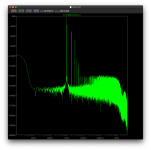
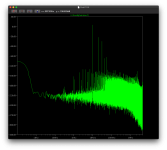
So considering you're not going to hear anything under ~100dB.. that's a pretty quiet non-negative feedback! It's got Class A tube harmonics too.
I still have some additional work - looking at the frequency response etc.
Just running a 60 second sim. Typically these are GB of info so and they take their time for the longer runs.
* Stacks are running +300 to -300 rather than 0-600V. There's an option to here to 'fold' the stack and have it all running nicely in less voltage but I'm saving that till later.
* Coscode stack now runs it's bias via a fixed voltage divider
* CCS on both stacks - set to 18mA so 9mA through each 6SN7.
* 6AS7s are now running a fixed bias but setup so that the resistances that the couple caps are identical, only issue is C2 needs 1.1KV through the resistor! There's got to be a better way to bias than have it with different resistances.
* removed the cross connects in the front end between the phases.
Result is this at 1KHz and 10KHz based on a 1 second run (so this is still settling after power up):


So considering you're not going to hear anything under ~100dB.. that's a pretty quiet non-negative feedback! It's got Class A tube harmonics too.
I still have some additional work - looking at the frequency response etc.
Just running a 60 second sim. Typically these are GB of info so and they take their time for the longer runs.
Last edited:
So there's some optimisations and perhaps 'simplifications' to the design needed, one such change is 'folding' the cascode. Essentially this means (a) you keep the benefits and (b) you reduce the voltages required (they're needed to provide headspace for each valve in the stack) to something a little more reasonable - that alone allows you to have a wider range of components to select from - instead of +300.0.-300 configuration (600V rail to rail!) this could, in theory, be dropped to +120.0.-120 (240V) for example. This also reduces heat, plus if the folding is performed by solid state (JFET or MOSFET) it allows the number of tubes to be reduced (again reducing the heater power & power requirements). The solid state can also be configured to have enough driving power for the 6AS7 output tubes with ease.
As the backend 6AS7s run at 120V, the power supply will most likely be a 250V split +120.0.-120 and some space for inefficiencies. Just using solid state, means two tubes are dropped saving a total (both channels) of 0.6*6.3*4 = 16W saving on the heater power supply, allowing a smaller PSU to be used.
This also reduces the real estate required for the amp (both channels) means 4 less tubes (6SN7 isn't particularly miniature).
I'm leaning towards JFETs at the moment, as these offer a flatter response curve. For safety, they will still need to support the voltage across the rails - a 5V part isn't going to work here!
As the backend 6AS7s run at 120V, the power supply will most likely be a 250V split +120.0.-120 and some space for inefficiencies. Just using solid state, means two tubes are dropped saving a total (both channels) of 0.6*6.3*4 = 16W saving on the heater power supply, allowing a smaller PSU to be used.
This also reduces the real estate required for the amp (both channels) means 4 less tubes (6SN7 isn't particularly miniature).
I'm leaning towards JFETs at the moment, as these offer a flatter response curve. For safety, they will still need to support the voltage across the rails - a 5V part isn't going to work here!
I've started on the simplification of the amp - currently it only has 0-320V (and 120V) power rather than the ±320 rails (ie 1/2 the voltage). I may up the power to 400V so the tubes have little more room. I've removed the upper set of tubes (this saves 2 tubes per channel) and currently use PNP transistors to reduce the cascode.
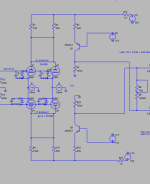
Starting to now focus on tuning this format, then I can design a power supply.

Starting to now focus on tuning this format, then I can design a power supply.
Working to reduce the power requirements further - this 'folding' allows you to implement constant current 'sink' (I1 & I2) and a constant current 'load' to replace the resistors (R6,R19,R25 and the mirrors). The only difference is that the output of the 6SN7 is current rather than voltage, this then uses the Q5 to drive R29 to create a voltage swing.
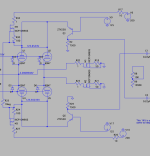
So this looks like it will work with 200V - thus should run off a 230V secondary. I still need some experienced feedback on this 'hybrid' design but the sim is looking ok.

So this looks like it will work with 200V - thus should run off a 230V secondary. I still need some experienced feedback on this 'hybrid' design but the sim is looking ok.
So I've been researching more.
1. I've switched to e88cc valves on the front end, these take less B+ voltage (two in cascode only need 400V rather than 600+V) AND more importantly, this offers easier headroom in a hybrid cascode. Lastly the heaters are less current too - bonus.
2. I've gone down to the maths, so now I have a better understanding of the PNP (ZTX588) to tune it. I now have 100V peak-to-peak swing going into the 6AS7s, this is enough for the 32ohm headphones as I get 4V-peak and 140mA. So there's some room to adjust. Also a more accurate term of this topology is a shunted cascode rather than a folded cascode.
To perform the same in valve land I would need e88cc valves for the upper valves of the cascode, and then a separate differential driver section paralleled (overboard but averages the noise thus keeps the SNR focus).
So for stereo the difference between using a PNP and keeping tubed:
PNP: 4x e88cc tubes (200V) + 2x 6AS7 tubes (120V)
Valves: 8x e88cc tubes (400V) + 4x6SN7 driver tubes (320V) + 2x 6AS7 tubes (120V)
Now the idea all along is to have a headphone amp that is both a DAC and an amplifier for analogue line-in.
Marcel G's original ValveDAC used three e88cc valves per channel with a butterworth filter that re-constructed the analogue (the benefit of DSD is it's easy to reproduce analogue). When you look at the topology it is very similar to a cascode, but the input signals are different and there's an interconnection differences top and bottom. The signal is a 5-20MHz digital on/off and a 27Mhz clock signal - again digital on/off.
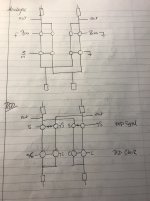
So this leads me to a few options (valves are quoted for stereo):
a) Have a separate (400V) 6 tube DAC converting DSD to line level and then the amplifier - either 10x e88cc+2x6as7 or 12xe88cc+4x6SN7+2x6as7s.
b) Combine the analogue and amplifier - make the 6 tubes 8 tubes, keep at 400V, then simply switch connections to switch between digital DAC amplification or analogue amplification using the same tubes. The PNP, now acting as a driver, will be at it's max being a 400V part but when you look at the design by shifting the tubes to be -400V to ground, the voltage at the top tubes is actually very low - around 100V which the ZTX558 are comfortable doing on a continuous basis. This would be 10 valves (8 e8cc and two 6AS7s).
c) Combine the two as for (b) but remove the upper tubes and using the PNP to it's fullest. Issue here for purists is that the DSD signal is normally fed into the top valves, but if I use this method this would be only the clock signal being valved, the DSD signal would have to be solid-state switching. The benefit is I still stick to 200V and only the smaller 4xe88cc+2x6AS7s.
1. I've switched to e88cc valves on the front end, these take less B+ voltage (two in cascode only need 400V rather than 600+V) AND more importantly, this offers easier headroom in a hybrid cascode. Lastly the heaters are less current too - bonus.
2. I've gone down to the maths, so now I have a better understanding of the PNP (ZTX588) to tune it. I now have 100V peak-to-peak swing going into the 6AS7s, this is enough for the 32ohm headphones as I get 4V-peak and 140mA. So there's some room to adjust. Also a more accurate term of this topology is a shunted cascode rather than a folded cascode.
To perform the same in valve land I would need e88cc valves for the upper valves of the cascode, and then a separate differential driver section paralleled (overboard but averages the noise thus keeps the SNR focus).
So for stereo the difference between using a PNP and keeping tubed:
PNP: 4x e88cc tubes (200V) + 2x 6AS7 tubes (120V)
Valves: 8x e88cc tubes (400V) + 4x6SN7 driver tubes (320V) + 2x 6AS7 tubes (120V)
Now the idea all along is to have a headphone amp that is both a DAC and an amplifier for analogue line-in.
Marcel G's original ValveDAC used three e88cc valves per channel with a butterworth filter that re-constructed the analogue (the benefit of DSD is it's easy to reproduce analogue). When you look at the topology it is very similar to a cascode, but the input signals are different and there's an interconnection differences top and bottom. The signal is a 5-20MHz digital on/off and a 27Mhz clock signal - again digital on/off.

So this leads me to a few options (valves are quoted for stereo):
a) Have a separate (400V) 6 tube DAC converting DSD to line level and then the amplifier - either 10x e88cc+2x6as7 or 12xe88cc+4x6SN7+2x6as7s.
b) Combine the analogue and amplifier - make the 6 tubes 8 tubes, keep at 400V, then simply switch connections to switch between digital DAC amplification or analogue amplification using the same tubes. The PNP, now acting as a driver, will be at it's max being a 400V part but when you look at the design by shifting the tubes to be -400V to ground, the voltage at the top tubes is actually very low - around 100V which the ZTX558 are comfortable doing on a continuous basis. This would be 10 valves (8 e8cc and two 6AS7s).
c) Combine the two as for (b) but remove the upper tubes and using the PNP to it's fullest. Issue here for purists is that the DSD signal is normally fed into the top valves, but if I use this method this would be only the clock signal being valved, the DSD signal would have to be solid-state switching. The benefit is I still stick to 200V and only the smaller 4xe88cc+2x6AS7s.
Looking at a solid state output rather than 6AS7s, I'm exploring this at the moment (just put in):
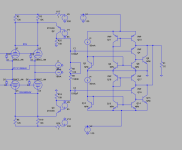
This has a common gate then a super follower as a voltage buffer - this presents a high impedance to the tubes and common gate (keeps the voltage swing) and then presents a low impedance to the headphones. The SF gain is less than 1 (same as 6AS7s) but is putting out about 400mA atm.
I'm attempting to get into the 0.0x-0.00x output impedance. Which is as good as a Chord Mojo..

This has a common gate then a super follower as a voltage buffer - this presents a high impedance to the tubes and common gate (keeps the voltage swing) and then presents a low impedance to the headphones. The SF gain is less than 1 (same as 6AS7s) but is putting out about 400mA atm.
I'm attempting to get into the 0.0x-0.00x output impedance. Which is as good as a Chord Mojo..
An update - I've decided to keep it simple but able to be enhanced over time.
The original Broksie design uses 12au7 and three ecc99 tubes. The input signal is amplified by the first 12au7 triode, the signal travels through the cathode into the second 12au7 - no amplification occurs except the signal feedback from the output is used to reduce noise/distortion. The signal then runs into the paralleled ecc99s. The DC is then blocked by C2&C3 and then the signal then goes out to headphones R19.
I've enhanced the design slightly, adding noise cancelling by channeling noise through the CCS (constant current source) M1 & M2, these act to limit the maximum current but also flatten the load line horizontally so it doesn't change slope and cause additional distortion.
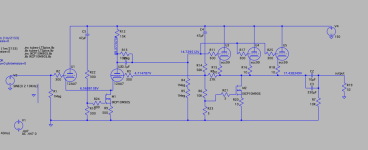
Exploring and simulating the circuit shows it's very good, but only when it's operating at the average 447mV peak of consumer line-in, as soon as you put 3.16V peak in (this is the recommended 20dbV headroom to cope with transients such as cymbols or electronica etc) the amount of harmonics increases heavily. Additionally and more importantly, over 1V peak input caused the output DC offset to increase giving +6V to -2V peak to peak, so something that headphones aren't going to like on a continuous basis.
447mV at 10KHz
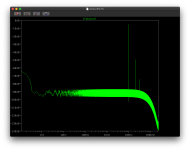
3.16V at 10Khz
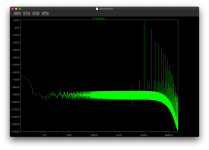
So tracing this offset issue comes back to the input section (12au7) is outputting a larger positive sine wave lobe - this is down to the tube load line and this asymmetric distortion is also the cause of the increased even harmonics.
The 12au7 isn't a particularly powerful driver tube - so typically it's operating with in the form 12au7->12ax7 to offload the driving of the next stage to the 12ax7.
I've considered switching the 12au7 to a 6sn7 which is the older version of the 12au7 and is more able to drive, has less noise, and is more linear but it's also considered to be a little more bassy/boomy. The 6sn7 improves the situation, but complicates the power requirements (320V).
3.16V 10Khz 6SN7 replacement (I'm more familiar with the 6SN7 hence my initial guess at operating it is better):
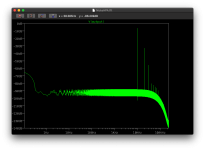
A suggestion for a more linear and less distortion is the 12bh7 which runs at 12V and 150V too.

First run and the first FFT for the 12BH7 bass amp gives, at 3.16V 10KHz:
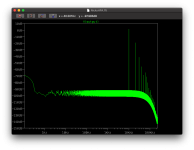
Take these with a pinch of salt as it's completely dependant on the LTSpice maths model for the valve, but they're normally reasonably accurate for the tube characteristics.
I still have some playing with the BH7 to see if I can reduce the harmonics a little further - the model also seems to suggest a lower noise floor than the 6SN7. However also remember that this is transients rather than normal playing volume.
However given the 'simplicity' of the design and it requiring 150V rather than above 230V, it should make the system a little easier to source components and cheaper.
Now.. the same design can be expanded with changes to the circuit to become a long-tailed-pair differential amp with push pull back end.
The original Broksie design uses 12au7 and three ecc99 tubes. The input signal is amplified by the first 12au7 triode, the signal travels through the cathode into the second 12au7 - no amplification occurs except the signal feedback from the output is used to reduce noise/distortion. The signal then runs into the paralleled ecc99s. The DC is then blocked by C2&C3 and then the signal then goes out to headphones R19.
I've enhanced the design slightly, adding noise cancelling by channeling noise through the CCS (constant current source) M1 & M2, these act to limit the maximum current but also flatten the load line horizontally so it doesn't change slope and cause additional distortion.

Exploring and simulating the circuit shows it's very good, but only when it's operating at the average 447mV peak of consumer line-in, as soon as you put 3.16V peak in (this is the recommended 20dbV headroom to cope with transients such as cymbols or electronica etc) the amount of harmonics increases heavily. Additionally and more importantly, over 1V peak input caused the output DC offset to increase giving +6V to -2V peak to peak, so something that headphones aren't going to like on a continuous basis.
447mV at 10KHz

3.16V at 10Khz

So tracing this offset issue comes back to the input section (12au7) is outputting a larger positive sine wave lobe - this is down to the tube load line and this asymmetric distortion is also the cause of the increased even harmonics.
The 12au7 isn't a particularly powerful driver tube - so typically it's operating with in the form 12au7->12ax7 to offload the driving of the next stage to the 12ax7.
I've considered switching the 12au7 to a 6sn7 which is the older version of the 12au7 and is more able to drive, has less noise, and is more linear but it's also considered to be a little more bassy/boomy. The 6sn7 improves the situation, but complicates the power requirements (320V).
3.16V 10Khz 6SN7 replacement (I'm more familiar with the 6SN7 hence my initial guess at operating it is better):

A suggestion for a more linear and less distortion is the 12bh7 which runs at 12V and 150V too.

First run and the first FFT for the 12BH7 bass amp gives, at 3.16V 10KHz:

Take these with a pinch of salt as it's completely dependant on the LTSpice maths model for the valve, but they're normally reasonably accurate for the tube characteristics.
I still have some playing with the BH7 to see if I can reduce the harmonics a little further - the model also seems to suggest a lower noise floor than the 6SN7. However also remember that this is transients rather than normal playing volume.
However given the 'simplicity' of the design and it requiring 150V rather than above 230V, it should make the system a little easier to source components and cheaper.
Now.. the same design can be expanded with changes to the circuit to become a long-tailed-pair differential amp with push pull back end.
Last edited:
So why the distortion?
Let's consider a simplification - using solid state. Source:https://www.theengineeringknowledge.com/transistor-dc-operating-point/
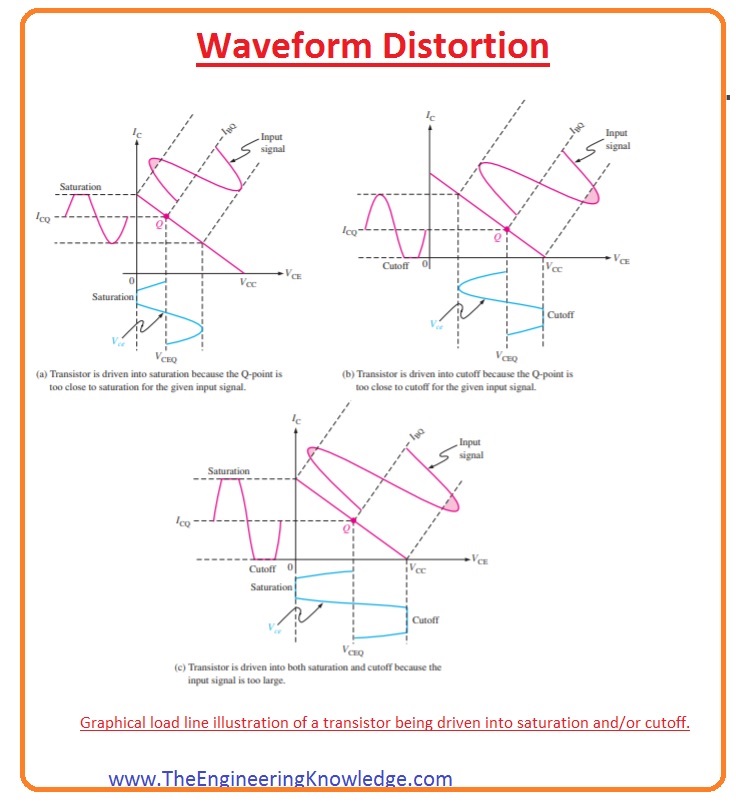
The sound input sine wave comes in (that's the input signal above) which results in current and voltage signal. The load line that cuts across the graph through the centre point Q. This line is dictated by the resistance of the load the tube output is driving, the voltage (ie the 150V or 320V I talked about) and the current - this is where you'd set a milli-amp idle point for the tubes.
A low impedance output means that load line will appear vertical - giving a large current change but small voltage movement (although to get the current through the resistance of the headphone it needs more voltage than your headphones state).
The above is simplified because the input to load line is linear (straight and equal on the up and down of the wave). Looking at a tube example from turner audio (source: http://www.turneraudio.com.au/OTL-amps-pros-cons.html ) shows why the OTL is difficult and extremely power inefficient:

You can see the lines for an output power tube - the sloped 0, -10, -20V etc are the tube's input lines and they're not linear as there's differing space between them. On this you can see also the maximum power which drops down is the maximum current*voltage power the tube can deliver.
The set of colourful lines show the resistance (or reactance) governed load lines for different impedances. As headphones vary in resistance (impedance) over frequencies, this is not quite as simple as it seems.
Things like push pull, class AB1 etc all add complications to the design and fundamentally complicate the calculation of the load lines (class AB1 for example has a kink in the load line that you try to bend around the maximum power line.
Even harmonics are created by non-symmetrical output - ie the input is distorted by the tube characteristics causing the top of the wave to be higher than the bottom of the wave is lower than the centre point.
Odd harmonics are created by symmetrical output or distortion such as the same distortion above and below the centre point - in class B that's kinks causes by amplifying the top and bottom separately for example.
So designing an amp is taking each tube's load lines - input to output, output to input.. to create a amplification of the signal with minimal distortion. The couple that with removing/cancelling noise.
Let's consider a simplification - using solid state. Source:https://www.theengineeringknowledge.com/transistor-dc-operating-point/

The sound input sine wave comes in (that's the input signal above) which results in current and voltage signal. The load line that cuts across the graph through the centre point Q. This line is dictated by the resistance of the load the tube output is driving, the voltage (ie the 150V or 320V I talked about) and the current - this is where you'd set a milli-amp idle point for the tubes.
A low impedance output means that load line will appear vertical - giving a large current change but small voltage movement (although to get the current through the resistance of the headphone it needs more voltage than your headphones state).
The above is simplified because the input to load line is linear (straight and equal on the up and down of the wave). Looking at a tube example from turner audio (source: http://www.turneraudio.com.au/OTL-amps-pros-cons.html ) shows why the OTL is difficult and extremely power inefficient:
You can see the lines for an output power tube - the sloped 0, -10, -20V etc are the tube's input lines and they're not linear as there's differing space between them. On this you can see also the maximum power which drops down is the maximum current*voltage power the tube can deliver.
The set of colourful lines show the resistance (or reactance) governed load lines for different impedances. As headphones vary in resistance (impedance) over frequencies, this is not quite as simple as it seems.
Things like push pull, class AB1 etc all add complications to the design and fundamentally complicate the calculation of the load lines (class AB1 for example has a kink in the load line that you try to bend around the maximum power line.
Even harmonics are created by non-symmetrical output - ie the input is distorted by the tube characteristics causing the top of the wave to be higher than the bottom of the wave is lower than the centre point.
Odd harmonics are created by symmetrical output or distortion such as the same distortion above and below the centre point - in class B that's kinks causes by amplifying the top and bottom separately for example.
So designing an amp is taking each tube's load lines - input to output, output to input.. to create a amplification of the signal with minimal distortion. The couple that with removing/cancelling noise.
Last edited:
I've got the go-ahead from the boss.. so I'll be ordering some hardware soon 
* 3x ecc99
* 2x 12bh7
* 5x B9A
* 6x IXCP10M90S (two per channel, and two in reserve current limit. They can cope with 300mA 40W and 900V max but 100mA sustained - more than enough. Heatsinked.
* 2x 10Kohm wire wound resistors for plate adjustment
* 2x 1Kohm wire wound resistors for CCS adjustment
* fixed resistors
* 450V coupling caps
* 450V output caps
* heater wire
* signal wire
* RCA socket
* headphone socket
* 230 to 200V trafo for B+
* Bridge diode
* Smoothing caps
* LM315 regulator
* power stage caps (ie between each second as the ground loop returns to the cap)
* Volume pot
* fast blow 350V 100mA fuses
* solder
* 32ohm test speaker
Trying to think of anything else.

* 3x ecc99
* 2x 12bh7
* 5x B9A
* 6x IXCP10M90S (two per channel, and two in reserve current limit. They can cope with 300mA 40W and 900V max but 100mA sustained - more than enough. Heatsinked.
* 2x 10Kohm wire wound resistors for plate adjustment
* 2x 1Kohm wire wound resistors for CCS adjustment
* fixed resistors
* 450V coupling caps
* 450V output caps
* heater wire
* signal wire
* RCA socket
* headphone socket
* 230 to 200V trafo for B+
* Bridge diode
* Smoothing caps
* LM315 regulator
* power stage caps (ie between each second as the ground loop returns to the cap)
* Volume pot
* fast blow 350V 100mA fuses
* solder
* 32ohm test speaker
Trying to think of anything else.
Last edited:
I’ve been planning out the power, or at least researching it.
It’s relatively simple to make a 200V unregulated supply, but what I don’t want todo is simply use a resistor to drop 50V given the 150V B+ rail will be 150mA but specced for 300mA - 50*.3 is 15Watts of heat!
There’s a number of ways to boost the voltage, a 50V secondary could be added in series with a 150V secondary to get 200.. then the fun starts.
The voltage drops - first across the rectification, then across regulation. I decided that regulation would be good, given if you go with unregulated you have to compute the voltage drop when the load is attached (ie the amp).
I’ve modelled a transformer LTSpice, so I will build up a regulated supply and work out how to get a the two voltages without wasting too much.. however regulated means putting a heatsink somewhere in the physical design.
I also thought that DC heaters (12.6V 2.5-3A) perhaps from a separate transformer - connected so they’re not floating, that way I can put the heater power elevated just a little (the cathode sits about 8-20V) not strictly needed but I hear it helps reduce hum/noise.
the power needs to have some wiggle room, the amp finer tuning for the valves is needed as each valve differs and the LTSpice model is good to get a general ball park. So then all the resistors are variable until a good operating point is found.
I’ve also tried drawing out point to point wiring.. and to make it easier it may be better to have equal valves - instead of 3 tubes output - ie one tube has both channels to simplify the wiring have left and right with 2 output tube each - then simply wire the unused triode to ground. With 4 triodes it would have to idle at 100mA per channel so not connecting the 4th reduces current to 75mA idle.
It also means the two channels are kept separate. Like monoblocks, making the wiring separate for each channel.
Then, I will add in a soft start with mute etc as the modelling has shown a 90V spike at power up. Valves start and if the grid is 0V and the B+ rises then the valve is wide open allowing maximum current - even beyond the power handling of the tube. Having a soft start compounds that risk as the start takes longer, so the idea is to soft start until the caps etc and regulation is ready then simply switch on the heater, grid bias and B+.
The design has a cathode sit at 8-20V so it’a possible to let the cathode rise quickly setting the bias instantly but the risk is a current spike - something I need to model a bit more. Old valve regulators took their time to start, hence a ramp up, so I need more thinking in this area too.
It’s relatively simple to make a 200V unregulated supply, but what I don’t want todo is simply use a resistor to drop 50V given the 150V B+ rail will be 150mA but specced for 300mA - 50*.3 is 15Watts of heat!
There’s a number of ways to boost the voltage, a 50V secondary could be added in series with a 150V secondary to get 200.. then the fun starts.
The voltage drops - first across the rectification, then across regulation. I decided that regulation would be good, given if you go with unregulated you have to compute the voltage drop when the load is attached (ie the amp).
I’ve modelled a transformer LTSpice, so I will build up a regulated supply and work out how to get a the two voltages without wasting too much.. however regulated means putting a heatsink somewhere in the physical design.
I also thought that DC heaters (12.6V 2.5-3A) perhaps from a separate transformer - connected so they’re not floating, that way I can put the heater power elevated just a little (the cathode sits about 8-20V) not strictly needed but I hear it helps reduce hum/noise.
the power needs to have some wiggle room, the amp finer tuning for the valves is needed as each valve differs and the LTSpice model is good to get a general ball park. So then all the resistors are variable until a good operating point is found.
I’ve also tried drawing out point to point wiring.. and to make it easier it may be better to have equal valves - instead of 3 tubes output - ie one tube has both channels to simplify the wiring have left and right with 2 output tube each - then simply wire the unused triode to ground. With 4 triodes it would have to idle at 100mA per channel so not connecting the 4th reduces current to 75mA idle.
It also means the two channels are kept separate. Like monoblocks, making the wiring separate for each channel.
Then, I will add in a soft start with mute etc as the modelling has shown a 90V spike at power up. Valves start and if the grid is 0V and the B+ rises then the valve is wide open allowing maximum current - even beyond the power handling of the tube. Having a soft start compounds that risk as the start takes longer, so the idea is to soft start until the caps etc and regulation is ready then simply switch on the heater, grid bias and B+.
The design has a cathode sit at 8-20V so it’a possible to let the cathode rise quickly setting the bias instantly but the risk is a current spike - something I need to model a bit more. Old valve regulators took their time to start, hence a ramp up, so I need more thinking in this area too.
Thank you - I think designing and amp is a bit like keeping all the plates spinning.
In terms of difficulty, I would say each step is probably 2x the difficulty:
1. designing your own topology/design, and supporting components
2. Using a known topology, and supporting components (but still having to work out the component values)
3. Using a known design with values
4. Using PCB unpopulated (as components you may have vs the designer vary)
5. Using pre-build PCBs as separate components assembled together
6. Buying it
So initially I was trying 2, then to 1, now I'm back to 2/1 (ie switching out the 12AU7 for 12BH7).
The current focus is on the power supply
* EMI choke - filter out the EMI from the mains and prevent EMI going back out.
* Transformer
* inrush protection
* regulation
* current limit
* 'soft' start for the amp.
An A class OTL is at max 50% efficient, and being OTL... that takes a nose drive. With the available non-custom you're looking at 100W transformers, but using a separate transformer for heaters may work out better. Although I can operate the heaters at 6.3 or 12.6V I want to limit the current flowing around the amp - current induces electromagnetic fields thus interference and noise.
Starting an amp in the old days.. literally they used valve rectifiers (with 100+V drop!) and that too a few seconds to ramp up voltage. The down side is bad current handling (sags) and it doesn't like driving large smoothing capactors.
Start up therefore now needs a couple of things in my view to design in extra; some caused by the more hard 'start' of silicon.
* Mute - this is more than a simply noise prevention (whistling etc), as the sim at startup sees a voltage peak of 90V on the rail before the output cap.. which means a spike out to both the headphones and through the feedback hitting the resistor and makes the grid of the front end go positive by about 20V it's a few milliseconds. The cathode then raises as it biases and the 20V positive, it then gets it's act together.. and it's then stabilises over then next few seconds. So a mute on the input and output would means a clean startup.
it's a few milliseconds. The cathode then raises as it biases and the 20V positive, it then gets it's act together.. and it's then stabilises over then next few seconds. So a mute on the input and output would means a clean startup.
* Grid - this needs to be negative to the cathode for the tubes I have on startup.. or the tube will suffer a full power surge.
* Heaters - the euro-tubes can suffer from what looks like a white hot section of element, as the heaters are hit instantly. A cold heater starts at low resistance and then as it heats it reaches it's operating resistance. So that's a high current surge through the heater wire. Not good for the tube, so a small 'soft start' of restricted current will allow the heater filament to handle the current without a surge. Once running the circuit can be switched out.
Inrush
A thermistor works presents a resistance, that resistance causes heat and as it heats the resistance drops and more current flows. Great. However in the scenario that the power is cycled when the thermistor is hot.. you have a full current surge. So I think the way I will do that is have a relay to short the thermistor out once running. That way the thermistor cools and any power cycling will be protected.
* voltage regulation
I'll probably use a mosfet as a voltage regulator, if I need more current then I can use a combination of solid state. If I can get down to the milli-volt ripple I will be happy. The mains power can vary ±10% from 230V, so in an unregulated amp, everything then follows that continuous varying 'float'.
Now in the past I through - more capacitors the better to prevent ripple. Well that works but is a little heavy handed. Valves are VOLTAGE rather than current driven devices, so regulation makes sense and enough capacitance to smooth ripple - and this is a headphone amp!). Little point in having a mass of capacitors if they're slow in providing power. Yes this design is more current focused than normal valve amps (think tens of mA but hundreds of volts) in that each ecc99 triode will drive 60mA max.. which is quite a bit for a small tube (6AS7 and the bigger power tubes will do 110mA+ each triode). I'm essentially using input tubes (12BH7 which is a more current orientated mini-driver but linear) and a driver tube (ecc99) rather than an output tube (the 6AS7 was made to be a power regulator current bypass tube.. but became an audio 'power' tube).
* current limit.
The design originally had a CCS (a current limiter) on the cathodes. That works when the current is only drawn through it - however this an OTL. So there is a link from ground to the cathode - and that is the via the headphones. So you can limit the CCS to 75mA but if you open up the valves (bias etc) there is a scenario where you can draw 3x60mA through the headphones and max out the output tubes causing damage across the board..
Instead I'll install a CCS on the TOP in addition. This means the maximum current being able to be drawn will be limited to 75mA - the bottom ensures a flat load line thus low distortion but the top is simply set as a safety limiter. Only thing is that a IXCP needs about 5V or so to operate - this means the B+ needs to be 155V rather than just 150V.
So the experience I'm looking for is press the power.. let the power button led flash as it starts up (ie going through the steps).. then the power button led goes solid... under the hood there's lots of thinking..
In terms of difficulty, I would say each step is probably 2x the difficulty:
1. designing your own topology/design, and supporting components
2. Using a known topology, and supporting components (but still having to work out the component values)
3. Using a known design with values
4. Using PCB unpopulated (as components you may have vs the designer vary)
5. Using pre-build PCBs as separate components assembled together
6. Buying it

So initially I was trying 2, then to 1, now I'm back to 2/1 (ie switching out the 12AU7 for 12BH7).
The current focus is on the power supply
* EMI choke - filter out the EMI from the mains and prevent EMI going back out.
* Transformer
* inrush protection
* regulation
* current limit
* 'soft' start for the amp.
An A class OTL is at max 50% efficient, and being OTL... that takes a nose drive. With the available non-custom you're looking at 100W transformers, but using a separate transformer for heaters may work out better. Although I can operate the heaters at 6.3 or 12.6V I want to limit the current flowing around the amp - current induces electromagnetic fields thus interference and noise.
Starting an amp in the old days.. literally they used valve rectifiers (with 100+V drop!) and that too a few seconds to ramp up voltage. The down side is bad current handling (sags) and it doesn't like driving large smoothing capactors.
Start up therefore now needs a couple of things in my view to design in extra; some caused by the more hard 'start' of silicon.
* Mute - this is more than a simply noise prevention (whistling etc), as the sim at startup sees a voltage peak of 90V on the rail before the output cap.. which means a spike out to both the headphones and through the feedback hitting the resistor and makes the grid of the front end go positive by about 20V
 it's a few milliseconds. The cathode then raises as it biases and the 20V positive, it then gets it's act together.. and it's then stabilises over then next few seconds. So a mute on the input and output would means a clean startup.
it's a few milliseconds. The cathode then raises as it biases and the 20V positive, it then gets it's act together.. and it's then stabilises over then next few seconds. So a mute on the input and output would means a clean startup.* Grid - this needs to be negative to the cathode for the tubes I have on startup.. or the tube will suffer a full power surge.
* Heaters - the euro-tubes can suffer from what looks like a white hot section of element, as the heaters are hit instantly. A cold heater starts at low resistance and then as it heats it reaches it's operating resistance. So that's a high current surge through the heater wire. Not good for the tube, so a small 'soft start' of restricted current will allow the heater filament to handle the current without a surge. Once running the circuit can be switched out.
Inrush
A thermistor works presents a resistance, that resistance causes heat and as it heats the resistance drops and more current flows. Great. However in the scenario that the power is cycled when the thermistor is hot.. you have a full current surge. So I think the way I will do that is have a relay to short the thermistor out once running. That way the thermistor cools and any power cycling will be protected.
* voltage regulation
I'll probably use a mosfet as a voltage regulator, if I need more current then I can use a combination of solid state. If I can get down to the milli-volt ripple I will be happy. The mains power can vary ±10% from 230V, so in an unregulated amp, everything then follows that continuous varying 'float'.
Now in the past I through - more capacitors the better to prevent ripple. Well that works but is a little heavy handed. Valves are VOLTAGE rather than current driven devices, so regulation makes sense and enough capacitance to smooth ripple - and this is a headphone amp!). Little point in having a mass of capacitors if they're slow in providing power. Yes this design is more current focused than normal valve amps (think tens of mA but hundreds of volts) in that each ecc99 triode will drive 60mA max.. which is quite a bit for a small tube (6AS7 and the bigger power tubes will do 110mA+ each triode). I'm essentially using input tubes (12BH7 which is a more current orientated mini-driver but linear) and a driver tube (ecc99) rather than an output tube (the 6AS7 was made to be a power regulator current bypass tube.. but became an audio 'power' tube).
* current limit.
The design originally had a CCS (a current limiter) on the cathodes. That works when the current is only drawn through it - however this an OTL. So there is a link from ground to the cathode - and that is the via the headphones. So you can limit the CCS to 75mA but if you open up the valves (bias etc) there is a scenario where you can draw 3x60mA through the headphones and max out the output tubes causing damage across the board..
Instead I'll install a CCS on the TOP in addition. This means the maximum current being able to be drawn will be limited to 75mA - the bottom ensures a flat load line thus low distortion but the top is simply set as a safety limiter. Only thing is that a IXCP needs about 5V or so to operate - this means the B+ needs to be 155V rather than just 150V.
So the experience I'm looking for is press the power.. let the power button led flash as it starts up (ie going through the steps).. then the power button led goes solid... under the hood there's lots of thinking..
I'm starting to feel a lot more confident around the design of the power. There's quite a bit of playing you can do with respect to power supplies. For example chaining 230V -> 24V -> 230V etc so it may be better running 230 -> 24V -> 180V & 220V, the 24V is high current! You don't need exact matching transformer taps (although it helps).
So to make a flexible power supply sounds more complex than I think it is:
Let me break this into three sections:
Section 1: 230V mains -> Combo fuse + hard power + EMI filter -> soft power switch -> transformer
So this means when you switch on the hard power, it's still powered down. When the soft power triggers, only the transformer sees inrush (they're build for it). I could add a thermistor here but it's probably not required.
Section2: transformer -> rectifier + current limiter -> smoothing caps -> power relay
So this section, once the section one soft power starts, sees an inrush into the smoothing caps, however the current limiter keeps the operational limit of current to normal levels. This limiter then means there's no inrush.. just the same maximum current as if in normal operation. I'll use a power relay so that the inrush doesn't then carry through the rest of the amp.
So the caps are charged, then it's time to soft start the amp.
Section 3 - heaters: power relay -> thermistor (or solid state limiter) -> voltage regulator -> tube heater filaments
So this means that the heaters have chance to get a few seconds of ramp up before the HT is switched on. As the tubes only conduct above a certain temp, this could mean random conductivity. If it's already hot you know the behaviour. Only a couple of seconds delay but enough. As we're using a regulator on the B+ high voltage, we can't have the heaters randomly floating without causing possible noise or worse.
The heaters get a smoothed power supply but then the caps need to be able to provide the current required. I don't need todo this but I figured it's more complication not to.
Limiter over-current detection - the amp could be made to shut down (soft power switch) should a high current be detected (indicating a short).
The heater relay can then also trigger the other B+ relays:
Section 3 - B+ power relay -> voltage regulator -> 200V B+ for front end tubes
Section 3 - B+ power relay -> voltage regulator -> 150V B+ for output end tubes
So with this I have two voltages being regulated, but they're both fed from a protected common set of smoothing capacitors. The regulator provides a final smooth. I thought about having dropper resistors, but my higher voltage would be at the other end of the chain, the current hungry monsters would be before it.. so it's very likely that the voltage would vary.
Second 4 (I lied) - mute relays on the input and output signal path.
These are connected so that on startup the system is muted, but on once all the amp is operating, the mutes are disabled.
This is power setup is complicated but it's also modular. It means I can switch out sections or bypass them as I change the amp. I know two areas that could drive this:
* cascode - this needs elevated supplies and also heater supplier for the upper cascoded tubes.
* push pull - this needs B+ and B- supply rails for example.
* change of tubes - change the voltage from the regulator.
* change the power delivery - I could use say 50V 10,000uF caps by converting from 230V to 24V (50A for example) and then paralleling the caps. I can then simply step up to any voltage and then regulate.
All depends.. but for now keeping it modular means each section does its bit.
In the old days the power supply would slowly ramp up voltage until it hit a specific level (and a cap is charged) which then unmutes the output relays. The valves can cope with it. Safety was - well if it shorted it blew a fuse and the sections were isolated by interstage or output transformers.. and a general disregard for the human..
So to make a flexible power supply sounds more complex than I think it is:
Let me break this into three sections:
Section 1: 230V mains -> Combo fuse + hard power + EMI filter -> soft power switch -> transformer
So this means when you switch on the hard power, it's still powered down. When the soft power triggers, only the transformer sees inrush (they're build for it). I could add a thermistor here but it's probably not required.
Section2: transformer -> rectifier + current limiter -> smoothing caps -> power relay
So this section, once the section one soft power starts, sees an inrush into the smoothing caps, however the current limiter keeps the operational limit of current to normal levels. This limiter then means there's no inrush.. just the same maximum current as if in normal operation. I'll use a power relay so that the inrush doesn't then carry through the rest of the amp.
So the caps are charged, then it's time to soft start the amp.
Section 3 - heaters: power relay -> thermistor (or solid state limiter) -> voltage regulator -> tube heater filaments
So this means that the heaters have chance to get a few seconds of ramp up before the HT is switched on. As the tubes only conduct above a certain temp, this could mean random conductivity. If it's already hot you know the behaviour. Only a couple of seconds delay but enough. As we're using a regulator on the B+ high voltage, we can't have the heaters randomly floating without causing possible noise or worse.
The heaters get a smoothed power supply but then the caps need to be able to provide the current required. I don't need todo this but I figured it's more complication not to.
Limiter over-current detection - the amp could be made to shut down (soft power switch) should a high current be detected (indicating a short).
The heater relay can then also trigger the other B+ relays:
Section 3 - B+ power relay -> voltage regulator -> 200V B+ for front end tubes
Section 3 - B+ power relay -> voltage regulator -> 150V B+ for output end tubes
So with this I have two voltages being regulated, but they're both fed from a protected common set of smoothing capacitors. The regulator provides a final smooth. I thought about having dropper resistors, but my higher voltage would be at the other end of the chain, the current hungry monsters would be before it.. so it's very likely that the voltage would vary.
Second 4 (I lied) - mute relays on the input and output signal path.
These are connected so that on startup the system is muted, but on once all the amp is operating, the mutes are disabled.
This is power setup is complicated but it's also modular. It means I can switch out sections or bypass them as I change the amp. I know two areas that could drive this:
* cascode - this needs elevated supplies and also heater supplier for the upper cascoded tubes.
* push pull - this needs B+ and B- supply rails for example.
* change of tubes - change the voltage from the regulator.
* change the power delivery - I could use say 50V 10,000uF caps by converting from 230V to 24V (50A for example) and then paralleling the caps. I can then simply step up to any voltage and then regulate.
All depends.. but for now keeping it modular means each section does its bit.
In the old days the power supply would slowly ramp up voltage until it hit a specific level (and a cap is charged) which then unmutes the output relays. The valves can cope with it. Safety was - well if it shorted it blew a fuse and the sections were isolated by interstage or output transformers.. and a general disregard for the human..
I now have a block diagram. It looks more complex than it is. I've also thought in how I can make a pure-digital DSD512 output 
I've also been looking at high voltage regulators, the difficulty is that most HV regulators for tube amps only handle ~50mA. Which is normally enough for a couple of tubes.
Interesting links for those following:
* Simple starter: https://www.electronics-notes.com/a...onics/linear-psu-series-regulator-circuit.php
* https://audioxpress.com/article/t-reg-a-high-voltage-regulator-for-tube-amps
* Broskie's article is good: https://www.pearl-hifi.com/06_Lit_A...ers/Broskie_John/HV_Regulator_OP27_IRF820.pdf
The Broskie regulator is good, it's a floating design (ie the 5V but sitting at 300V!) and uses the AC heater power line to shore up the B+ line.
I will need to adjust it, given I have two B+ lines and a heater line of 12.6V not 6.3V that will be DC.
Also on my hit list of research is SCR crowbars. The purpose for these is to detect over-voltage and simply short circuit the power. Faster than a fuse. I will put the SCR on the headphone side of the output caps, the SCR is then tied to the main transformer fuse. If the headphones get over a certain voltage the SCR shorts the transformer mains fuse and short the entire system to ground. Naturally a nuclear last resort. However I will also have current limiters anyway and positive-cathode bias for startup. This means if the power goes over 1.5V for example.. there's a problem and POP the headphones are shorted out from the supply. Not sure if it would like plugging of headphones.. so.
There's probably about 12-15 block types - sounds complex but they could be as simple as a zenner or a relay. Also not all of them are needed from day 1.
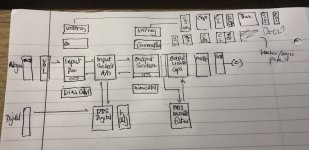
Day 1 would be:
* EMI (fuse inbuilt)
* hard power switch only
* Soft Start Current limit - stops the big 'hum' when you turn on the power, it should also mean the power comes up a little less abruptly.
* Tran + output fuse
* Caps
* Volume
* Input section + CCS
* Output section + CCS
* Output section B+ current limit (as OTL B+ has lower CCS and from headphone) - although on start the mute means the current is limited from the CCS already
* Output Caps
* Mute relay
Initially I'll not be plugging in my headphones but first a 32ohm resistor then a pair of 32ohm speakers (ie the £5) which have similar power characteristics.
Day 2
* Voltage regulators - improves noise and hum, with a 1ohm sense resistor these can also regulate current.
* delayed start bias offsetting (ie stops the grids from being wide open at 0V on B+ start for maximum current!)
* SCR
* automated startup - this performs the steps with isolated relays switching and provides a soft start button.
Day 3 - Digital
* Source/drive selection
* Digital DSD signal injection into the output section
* Digital DSD reconstruction filter switched in before the output caps.
The idea is that rather than use a balanced output from a DAC, instead the digital signal is fed straight into the output section grid. So the output switches either on or off only (no signal amplification). The reconstruction filter then sums the pulses and filters out the 24MHz switching speed. A Volume on the output is then needed but by that stage I may make a digital volume control.
The beauty of this is I can set the grid voltage for 1 and 0 separately so I get a symmetrical output.
Only issue here is that each valve triode has its own variation, so this needs exploring further, or at least average it - the beauty is it only needs 0 and 1 output so the tubes don't have to match up much.
I will have to see of the ecc99 can cope with ~25MHz signal or if it has problems.

I've also been looking at high voltage regulators, the difficulty is that most HV regulators for tube amps only handle ~50mA. Which is normally enough for a couple of tubes.
Interesting links for those following:
* Simple starter: https://www.electronics-notes.com/a...onics/linear-psu-series-regulator-circuit.php
* https://audioxpress.com/article/t-reg-a-high-voltage-regulator-for-tube-amps
* Broskie's article is good: https://www.pearl-hifi.com/06_Lit_A...ers/Broskie_John/HV_Regulator_OP27_IRF820.pdf
The Broskie regulator is good, it's a floating design (ie the 5V but sitting at 300V!) and uses the AC heater power line to shore up the B+ line.
I will need to adjust it, given I have two B+ lines and a heater line of 12.6V not 6.3V that will be DC.
Also on my hit list of research is SCR crowbars. The purpose for these is to detect over-voltage and simply short circuit the power. Faster than a fuse. I will put the SCR on the headphone side of the output caps, the SCR is then tied to the main transformer fuse. If the headphones get over a certain voltage the SCR shorts the transformer mains fuse and short the entire system to ground. Naturally a nuclear last resort. However I will also have current limiters anyway and positive-cathode bias for startup. This means if the power goes over 1.5V for example.. there's a problem and POP the headphones are shorted out from the supply. Not sure if it would like plugging of headphones.. so.
There's probably about 12-15 block types - sounds complex but they could be as simple as a zenner or a relay. Also not all of them are needed from day 1.

Day 1 would be:
* EMI (fuse inbuilt)
* hard power switch only
* Soft Start Current limit - stops the big 'hum' when you turn on the power, it should also mean the power comes up a little less abruptly.
* Tran + output fuse
* Caps
* Volume
* Input section + CCS
* Output section + CCS
* Output section B+ current limit (as OTL B+ has lower CCS and from headphone) - although on start the mute means the current is limited from the CCS already

* Output Caps
* Mute relay
Initially I'll not be plugging in my headphones but first a 32ohm resistor then a pair of 32ohm speakers (ie the £5) which have similar power characteristics.
Day 2
* Voltage regulators - improves noise and hum, with a 1ohm sense resistor these can also regulate current.
* delayed start bias offsetting (ie stops the grids from being wide open at 0V on B+ start for maximum current!)
* SCR
* automated startup - this performs the steps with isolated relays switching and provides a soft start button.
Day 3 - Digital
* Source/drive selection
* Digital DSD signal injection into the output section
* Digital DSD reconstruction filter switched in before the output caps.
The idea is that rather than use a balanced output from a DAC, instead the digital signal is fed straight into the output section grid. So the output switches either on or off only (no signal amplification). The reconstruction filter then sums the pulses and filters out the 24MHz switching speed. A Volume on the output is then needed but by that stage I may make a digital volume control.
The beauty of this is I can set the grid voltage for 1 and 0 separately so I get a symmetrical output.
Only issue here is that each valve triode has its own variation, so this needs exploring further, or at least average it - the beauty is it only needs 0 and 1 output so the tubes don't have to match up much.
I will have to see of the ecc99 can cope with ~25MHz signal or if it has problems.
Last edited:
This is what I have in mind for the digital day 3 - just using a single ecc99 here but this is the full output section:
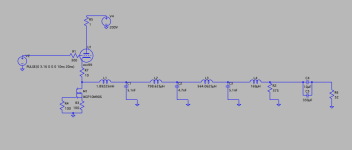
Sim wise this looks like it could work. However reality may prove more problematical.
I'd clock and pulse the signal then ping it over a galvanise isolator to the valve grid. The large number of coils after is a filter that converts the 10nS pulses to a DC level.. the DSD512 encoding then makes that rise and fall in a standard sine wave. The sim shows this works, just a little slow!

Sim wise this looks like it could work. However reality may prove more problematical.
I'd clock and pulse the signal then ping it over a galvanise isolator to the valve grid. The large number of coils after is a filter that converts the 10nS pulses to a DC level.. the DSD512 encoding then makes that rise and fall in a standard sine wave. The sim shows this works, just a little slow!
Last edited:


